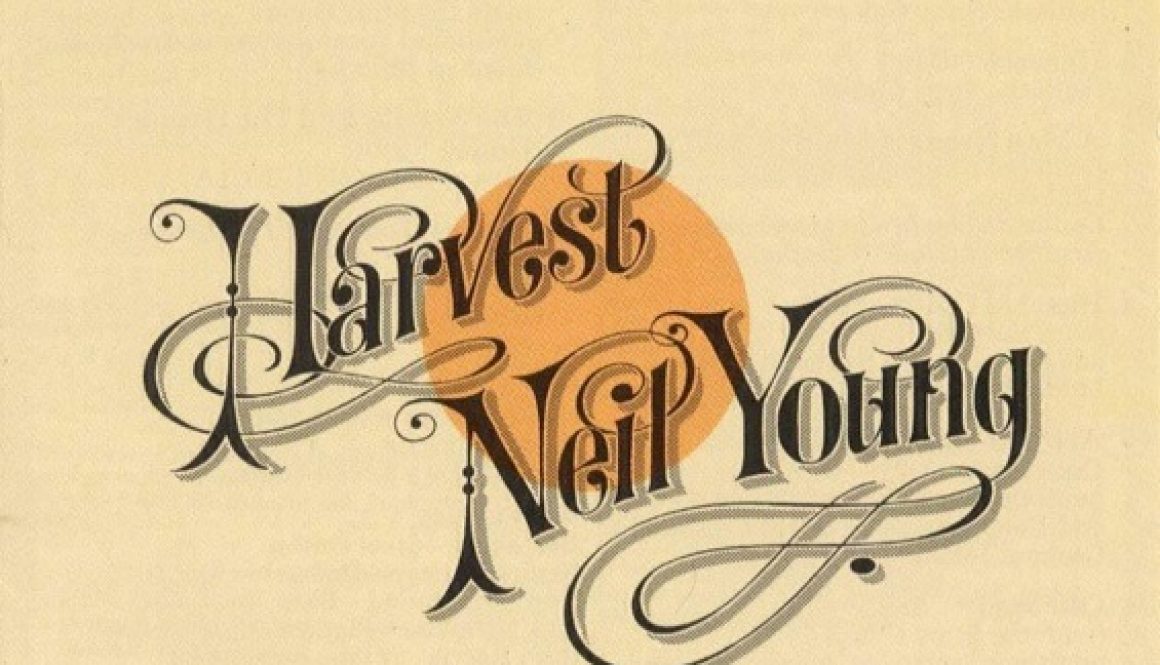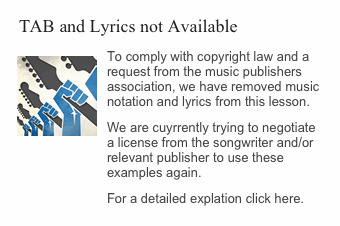Heart of Gold – Neil Young

Okay, let’s play a game. Pretend that you didn’t read the title of this lesson. Please? Instead, let’s just say that I’d like you to play this chord progression:
Em (four beats) D (two beats) Em (two beats)
Ready? We’re going to play it two ways:
Chances are that example #1A sounded fairly generic. It could have been any song. But you ears really perked up when you played example #1B. “Hey!” you probably said, “I sound like Neil Young!” Cool, isn’t it?
Even more to the point: How hard was that to do? The strumming was pretty much all eighth notes, played with down strokes for emphasis. As for the hammer-on, well, you’re playing an Em chord immediately beforehand, right? Just take whatever finger you’re using to fret the A string, remove it, pick said A string and slam your finger back on to the second fret. Then pick the D string (where your finger should still be on the second fret). Voila! Some people like to do this by using both of their Em chord fingers. That’s perfectly fine. As you can hear, I then hit the open low E (sixth) string to start out the next measure. For me it’s just a way of keeping the tempo.
Okay, since we’ve just covered the intro (believe it or not), let’s get this out of the way before we go any further:
These files are the author’s own work and represent his interpretation of this song. They are intended solely for private study, scholarship or research.
On the original recording of Heart of Gold, the intro actually consists of this part we’ve just played and then what we’re calling the “verse.” We’ll touch on this in a moment, after we’ve covered the rest of the song structure. What we’ve got is your classic verse-chorus-verse-chorus song. During the verses, each chord lasts two beats:
The chords are certainly simple enough, aren’t they? Let’s work on the rhythm of the verses. I’ve laid out three different ways of doing this, but, as always, you can and should feel free to come up with your own:
Our first pattern, Example #2A, consists of straight chord strumming. There’s nothing fancy here, just solid rhythm. Take your time and get the rhythm into your head and hands and once you’re confident that you can do it, then move on to the next strumming examples.
Example #2B shows you something a little closer to the quintessential Neil Young strum. The first two notes are played with a bit of palm muting and then the guitar sings out the rest of the chord. There are so many ways to explain palm muting! Everyone seems to have his or her own technique. In fact, when I teach my students about palm muting most of them say, “I do that all the time when I’m goofing around.”
Let’s start out with the simplest: First, play a single note, any note. Use the C (third fret on the A string) that I play in the example if you’d like. Keep your strumming hand close to the string when you pick it. Now play it again while resting a bit of your palm lightly against the string. The idea is to get a muted version of that note. If you don’t hear a thing, you’re putting too much pressure on the string. It’s important to realize that you don’t need all that much pressure at all.
Like most things about the guitar, this is a matter of practice and experimentation. It’s a great technique to add to your playing because it can help give your guitar a very different tonal characteristic. Be sure to try it not only with single notes, but with chords and partial chords as well.
Finally, what do you say we try something like the rhythm style we used in our last lesson, Dock of the Bay. Even though I call it “straight arpeggios” on the MP3, in reality it’s a combination of arpeggios and partial chords (two or three notes). In Example #2C I start out with the bass note (here the lowest root of the chord) and then pick a few strings of the chord being played On the C chord it’s the C note, then the open G string, followed by the first two strings and then the C in the bass again. This can be very dramatic because it gives you the sound of a walking bass line by hitting the C right before going to the open D string that starts the D chord. As always, this is a suggested pattern. Feel free to come up with a few of your own.
Now let’s go back to the intro for a second. On the recorded version, the full intro actually starts with the little thing we did at the very beginning of the lesson (Example #1B) and then goes into a round of the verse and then back to Example #1B. This is where the first harmonica solo can be heard. This intro section is also played between the two verses of the song. Or, if you’re going to be nitpicky, after the first chorus and before the second verse.
Okay, shall we move on to the chorus?
From our Em chord, we go to G and then to C. I like to accent this chord with a little flourish: going from C to Cmaj9 and then back to C. This is the same thing we did in the Love The One You’re With lesson. Play the normal C twice, then lift off your index and middle fingers, leaving your ring finger on the C note at the third fret of the A string. Then return to the normal C chord. It’s simple and effective. And it helps make up for you not having all the instrumentation of the original recording by having something more interesting than straight strumming going on.
We’re now going to play the C chord one more time and then B (second fret, A string) and A (open A string) and then hit your G chord. In the MP3 you’ll hear me do this with just the C note (single string as opposed to the full chord) the first time and then with the whole C chord (as in the transcription) on the second pass through the progression. You can also do this descending walk as full chords, going from C to C/B (X22010) to C/A (or Am7 if you prefer – either way it’s X02010). Each of these ways will work fine.
From this G chord we’re going to go back to Em (either in repeating the chorus or going back to the Intro part), so let’s take advantage of what Nick Torres calls “the world’s easiest bass run” – descending from G to Em via F#. Since we’re already on the G, we will hit the single F# note (second fret on the low E (sixth) string) to set up the Em chord that will cycle us around again.
So how about putting them all together? Here is Example #1B, followed by the verse, followed by the chorus:
Finally, let’s play the outro. It’s all stuff we’ve already done. Start with the Em to D and back progression from Example #1B. Then we’re going to go to a G chord and then switch to C. Finally tack on the little flourish and descending C to G line from the chorus and finish it all off with a resounding G chord. Here’s how it goes:
I hope you had fun with this lesson and have fun with this song. Remember the way you strum something can be all you need to change something from mediocre to memorable. Also remember that the simplest of touches, even a single hammer-on, can bring about as much eloquence as a difficult riff.
As always, please feel free to write in with any questions, comments, concerns or songs (and/or riffs and solos) you’d like to see discussed in future pieces. You can either drop off a note at the Guitar Forums or email me directly at [email protected].
Until next lesson…
Peace
Heart of Gold for Harmonica Players
Neil Young’s Heart of Gold is a classic guitar-harmonica song. Now that you’ve learned this song on guitar, you can learn the harmonica part. Check out the excellent free lesson over at HarmonicaLessons.com.
On February 11, 2010 we received a letter from lawyers representing the NMPA and the MPA instructing us to remove guitar tab and lyrics from this page. You can read more about their complaint here. Alternatively, you can still find this complete article with tab and lyrics archived here.


Paul Halton
February 8th, 2014 @ 7:06 am
Brilliant. Thank you. I stumbled across this page while looking for simple love songs for Valentine’s day. I have been here 5 minutes and I am completely hooked. Thanks again.
David Pfaffenbach
November 29th, 2012 @ 8:20 am
I started to learn from you and Gibson lessons about six year’s ago and I thank you and the many other’s for all the great lesson’s. I’m still learning little by little;Oh thats a song I stiil have to learn. thank you!!!